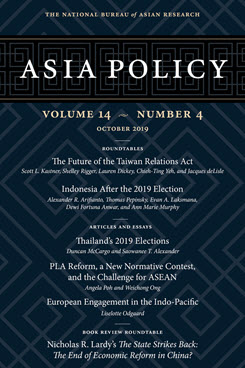The Future of the Taiwan Relations Act
Adaptation and Continuity
Since the creation of the Taiwan Relations Act (TRA) as a Cold War pact, it has evolved to become the cornerstone of a remarkable partnership. Yet with rapid changes in technology, trade, and regional security, and a rising China that continues to assert its claim to the island, is the TRA now too weak to serve its enlarged role? This Asia Policy roundtable addresses how emerging trends in trade, diplomacy, policy, security, democracy, and human rights could affect U.S.-Taiwan relations and, by extension, the TRA and U.S. policy toward Taiwan. It also considers the TRA as the legal basis for the U.S.-Taiwan partnership.
Introduction
The U.S.-Taiwan Commercial Relationship: Moving toward a Free Trade Agreement?
Scott L. Kastner
The Taiwan Relations Act: Past, Present, Future
Shelley Rigger
Change and Continuity in U.S.-Taiwan Security Ties
Lauren Dickey
The Evolution of Human Rights in Taiwan and Challenges from China
Chieh-Ting Yeh
The Taiwan Relations Act at 40: A Troubled but Durable Legal Framework for U.S. Policy
Jacques deLisle
Introduction
On April 10, 2019, the Taiwan Relations Act (TRA) turned 40 years old. Much fanfare has surrounded the anniversary of this unique piece of legislation, which has served as the foundation for U.S. relations with Taiwan since the United States switched diplomatic recognition to the People’s Republic of China (PRC) in 1979. Since its creation as a Cold War pact, the TRA has evolved to become the cornerstone of a remarkable partnership—at the time of enactment, few would have guessed the dimensions of the U.S.-Taiwan relationship that it would come to support. Yet with rapid changes in technology, trade and economics, and regional security, and a rising PRC that continues to assert its claim to the island, is the TRA now too weak to serve its enlarged role?
To better support current U.S.-Taiwan relations, Congress has recently supplemented the TRA with legislation such as the Taiwan Travel Act, the Asia Reassurance Initiative Act, and a resolution to reaffirm the United States’ commitment to the TRA. In addition to U.S.-provided military assistance, the United States and Taiwan partner to uphold democracy, combat terrorism, provide humanitarian assistance, and advance health and social issues. After four decades, it is thus worth considering where U.S.-Taiwan relations are headed and the implications for the TRA.
This Asia Policy roundtable assembles perspectives on how emerging trends in trade, diplomacy, policy, security, democracy, and human rights could affect U.S.-Taiwan relations and, by extension, the TRA and U.S. policy toward Taiwan. It also considers the TRA as the legal basis for the U.S.-Taiwan partnership as well as a potential vehicle for any significant change therein.
Scott Kastner’s essay examines trade and economic relations in what he terms a “golden age for the U.S.-Taiwan relationship.” He argues that, building on this already strong relationship, the United States and Taiwan should begin negotiating a bilateral free trade agreement to resolve persistent trade disagreements and prevent further marginalization of Taiwan in global trade frameworks. Shelley Rigger’s essay addresses the political relationship between Taiwan and the United States. In her view, the TRA is still valuable—although it satisfies no one, the ambiguity and flexibility it provides is a virtue, not a vice. The construction of an alternative architecture for U.S.-Taiwan relations that meets the requirements of the United States, Taiwan, and China is difficult to foresee.
An important component of the TRA has always been the security and defense relationship it establishes between the United States and Taiwan. While the basis provided by the TRA has remained constant, Lauren Dickey notes that U.S. perceptions of the threat from China have changed in recent years. Her essay seeks to make sense of the change and continuity in U.S.-Taiwan security ties and the role of the TRA in the U.S.-Taiwan-China triangle. Chieh-Ting Yeh reminds us that Taiwan has undergone a significant evolution since the TRA’s creation, transforming itself from a repressive authoritarian regime into a liberal democracy that respects human rights. His essay examines the creation of a human rights culture in Taiwan, the challenge China’s government poses both to human rights and to media and narrative freedoms, and the TRA as a foundation for deeper cooperation on human rights and civil freedoms between the United States and Taiwan.
Last, Jacques deLisle’s essay reflects on the legal and political underpinnings of the TRA in U.S.-Taiwan relations. He argues that the TRA has provided a sustainable and adaptable basis for ongoing U.S.-Taiwan relations, albeit below a true state-to-state level. Though the TRA has faced challenges and exhibited shortcomings, its flexibility makes it resilient and unlikely to be significantly supplemented.
The authors in this roundtable concur that the TRA has endured as the cornerstone of U.S.-Taiwan relations and the United States’ Taiwan policy because of its adaptability and versatility over the last 40 years. As deLisle notes, “the TRA’s emphasis on process and articulation of general principles have allowed it to accommodate significant change in U.S.-Taiwan relations and U.S. policy toward Taiwan while maintaining overall continuity and consistency.” Looking forward, the act will likely continue to play this role even as the bilateral relationship and trilateral relations with China change over time, and even as new U.S. policy measures are passed. Each of the areas examined in this roundtable—economics and trade, politics, security, and human rights cooperation—offers room for U.S.-Taiwan relations to grow within the framework of the TRA.
About Asia Policy
Asia Policy is a peer-reviewed scholarly journal presenting policy-relevant academic research on the Asia-Pacific that draws clear and concise conclusions useful to today’s policymakers. Asia Policy is published quarterly in January, April, July, and October and accepts submissions on a rolling basis. Learn more


